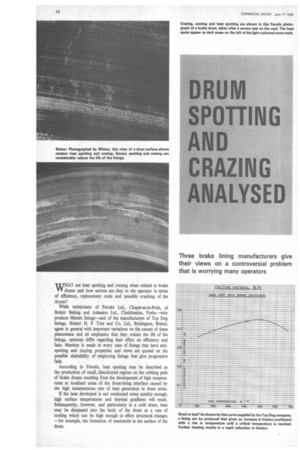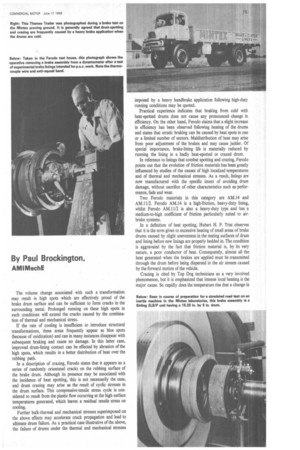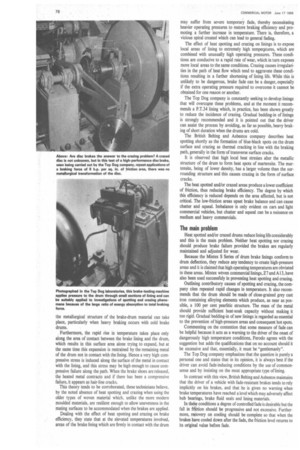DRUM SPOTTING AND CRAZING ANALYSED
Page 76

Page 77

Page 78

If you've noticed an error in this article please click here to report it so we can fix it.
WidiAT are heat spotting and crazing when related to brake rums and how serious are they to the operator in terms of efficiency, replacement costs and possible cracking of the drums?
While technicians of Ferodo Ltd., Chapel-en-le-Frith, of British Belting and Asbestos Ltd., Cleckheaton, Yorks—who produce Mintex linings—and of the manufacturers of Top Dog linings, Hubert H. P. Trist and Co. Ltd., Brislington, Bristol, agree in general with important variations on the causes of these phenomena and all emphasize that they reduce the life of the linings, opinions differ regarding their effect on efficiency and fade. Mention is made in every case of linings that have antispotting and crazing properties and views are quoted on the possible desirability of employing linings that give progressive fade.
According to Ferodo, heat spotting may be described as the production of small, discoloured regions on the rubbing path of brake drums resulting from the development of high temperatures at localized areas of the drum-lining interface caused by the high instantaneous rate of heat generation in these areas.
If the heat developed is not conducted away quickly enough, high surface temperatures and thermal gradients will result. Subsequently, however, and particularly in a cold drum, heat may be dissipated into the body of the drum at a rate of cooling which can be high enough to effect structural changes —for example, the formation of martensite in the surface of the drum.
Good or bad? As shown by this curve supplied by the Top Dog company, a lining can be produced that gives an increase in friction coefficient with a rise in temperature until a critical temperature is reached. Further heating results in a rapid reduction in friction.
The volume change associated with such a transformation may result in high spots which are effectively proud of the brake drum surface and can be sufficient to form cracks in the surrounding metal. Prolonged running on these high spots in such conditions will extend the cracks caused by the combination of thermal and mechanical stress.
If the rate of cooling is insufficient to introduce structural transformations, these areas frequently appear as blue spots (because of oxidization) and can in many instances disappear with subsequent braking and cause no damage. In this latter case, improved drum-lining contact can be effected by abrasion of the high spots, which results in a better distribution of heat over the rubbing path.
In a description of crazing, Ferodo states that it appears as a series of randomly orientated cracks on the rubbing surface of the brake drum. Although its presence may be associated with the incidence of heat spotting, this is not necessarily the case, and drum crazing may arise as the result of cyclic stresses in the drum surface. This compressive-tensile stress cycle is considered to result from the plastic flow occurring at the high surface temperatures generated, which leaves a residual tensile stress on cooling.
Further bulk-thermal and mechanical stresses superimposed on the above effects may accelerate crack propagation and lead to ultimate drum failure. As a practical case illustrative of the above, the failure of drums under the thermal and mechanical stresses imposed by a heavy handbrake application following high-duty running conditions may be quoted.
Practical experience indicates that braking from cold with heat-spotted drums does not cause any pronounced change in efficiency. On the other hand, Ferodo claims that a slight increase in efficiency has been observed following heating of the drums and states that erratic braking can be caused by heat spots in one or a limited number of sectors. Maldistribution of heat may arise from poor adjustment of the brakes and may cause judder. Of special importance, brake-lining life is materially reduced by running the lining in a badly heat-spotted or crazed drum.
In reference to linings that combat spotting and crazing, Ferodo points out that the evolution of friction materials has been greatly influenced by studies of the causes of high localized temperatures and of thermal and mechanical stresses. As a result, linings are now manufactured with the specific intent of avoiding drum damage, without sacrifice of other characteristics such as performance, fade and wear.
Two Ferodo materials in this category are AM.14 and AM.11/2. Ferodo AM.14 is a high-friction, heavy-duty lining, whilst Ferodo AM.11/2 is also a heavy-duty type and has a medium-to-high coefficient of friction particularly suited to airbrake systems.
In a definition of heat spotting, Hubert H. P. Trist observes that it is the term given to excessive heating of small areas of brake drums caused by slight unevenness in the mating surfaces of drum and lining before new linings are properly bedded in. The condition is aggravated by the fact that friction material is, by its very nature, a poor conductor of heat. Consequently, almost all the heat generated when the brakes are applied must be transmitted through the drum before being dispersed in the air stream caused by the forward motion of the vehicle.
Crazing is cited by Top Dog technicians -as a very involved phenomenon, but it is emphasized that intense local heating is the major cause. So rapidly does the temperature rise that a change in the metallurgical structure of the brake-drum material can take place, particularly when heavy braking occurs with cold brake drums.
Furthermore, the rapid rise in temperature takes place only along the area of contact between the brake lining and the drum. which results in this surface area alone trying to expand, but at the same time this expansion is restrained by the remaining metal of the drum not in contact with the lining. Hence a very high compressive stress is induced along the surface of the metal in contact with the lining, and this stress may be high enough to cause compressive failure along the path. When the brake shoes are released. the heated metal contracts and if there has been a compressive failure, it appears as hair-line cracks.
This theory tends to be corroborated. these technicians believe. by the noted absence of heat spotting and crazing when using the older types of woven material which. unlike the more modern moulded materials, are resilient enough to allow unevenness in the mating surfaces to be accommodated when the brakes are applied.
Dealing with the effect of heat spotting and crazing on brake efficiency, they state that at the elevated temperatures involved, areas of the brake lining which are firmly in contact with the drum may suffer from severe temporary fade, thereby necessitating heavier operating pressures to restore braking efficiency and promoting a further increase in temperature. There is, therefore, a vicious spiral created which can lead to general fading.
The effect of heat spotting and crazing on linings is to expose local areas of lining to extremely high tempergures, which are combined with unusually high operating pressures. These conditions are conducive to a rapid rate of wear, which in turn exposes more local areas to the same conditions. Crazing causes irregularities in the path of heat flow which tend to aggravate these conditions resulting in a further shortening of lining life. While this is unlikely to be dangerous, brake fade can be a danger, especially if the extra operating pressure required to overcome it cannot be obtained for one reason or another.
The Top Dog company is constantly seeking to develop linings that will overcottne these problems, and at the moment it recommends a P.T.34 lining which, in practice, has been shown greatly to reduce the incidence of crazing. Gradual bedding-in of linings is strongly recommended and it is pointed out that the driver can assist the process by avoiding, as far as possible, heavy braking of short duration when the drums are cold.
The British Belting and Asbestos company describes heat spotting shortly as the formation of blue-black spots on the drum surface and crazing as thermal cracking in line with the braking path, generally in the form of transverse surface cracks.
It is observed that high local heat stresses alter the metallic structure of the drum to form heat spots of martensite. The martensite, being of lower density, has a larger volume than the surrounding structure and this causes crazing in the form of surface cracks.
The heat spotted and/or crazed areas produce a lower coefficient of friction, thus reducing brake efficiency. The degree by which this efficiency is reduced depends on the area affected, but is not critical. The low-friction areas upset brake balance and can cause chatter and squeal. Imbalance is only evident on cars and light commercial vehicles, but chatter and squeal can be a nuisance on medium and heavy commercials.
The main problem Heat spotted and/or crazed drums reduce lining life considerably and this is the main problem. Neither heat spotting nor crazing should produce brake failure provided the brakes are regularly maintained and adjusted for wear.
Because the Mintex S Series of drum brake linings conform to drum deflection, they reduce any tendency to create high-pressure areas and it is claimed that high operating temperatures are obviated in these areas. Mintex woven commercial linings, Z 7 and A13, have also been used successfuly in preventing heat spotting and crazing.
Outlining contributory causes of spotting and crazing, the company cites repeated rapid changes in temperature. It also recommends that the drum should be made of close-grained grey cast iron containing alloying elements which produce, as near as possible, a 100 per cent pearlitic structure. The mass of the metal should provide sufficient heat-soak capacity without making it too rigid. Gradual bedding-in of new linings is regarded as essential to the prevention of high-pressure areas and consequent hot spots.
Commenting on the contention that some measure of fade can be helpful because it acts as a warning to the driver of the onset of dangerously high temperature conditions, Ferodo agrees with the suggestion but adds the qualifications that on no account should it be excessive and that, essentially, it must be "gentlemanly".
The Top Dog company emphasizes that the question is purely a personal one and states that in its opinion, it is always best if the driver can avoid fade-inducing conditions by the use of commonsense and by insisting on the most appropriate type of lining.
In contrast with this view. British Belting and Asbestos maintains that the driver of a vehicle with fade-resistant brakes tends to rely implicitly on his brakes, and that he is given no warning when brake temperatures have reached a level which may adversely affect hub bearings, brake fluid seals and lining materials.
In these conditions a degree of controlled fade is desirable but the fall in friction should be progressive and not excessive. Furthermore, recovery on cooling should be complete so that when the brakes have cooled down after the fade, the friction level returns to its original value before fade.




















































































































































